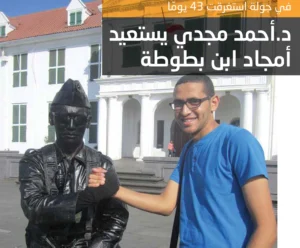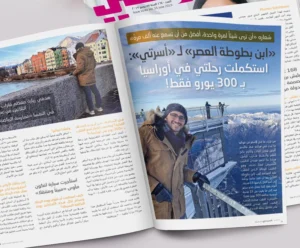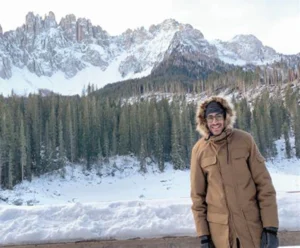
“The Ibn Battuta of Our Time” to Osraty: I Completed My Journey Across Eurasia With Only 300 Euros!
To begin with, how did the idea come to you? And why did you choose the title 200 Days in Eurasia for your book?
During one of my television interviews about the Triple Asia Journey—a trip during which I visited 15 cities across Asia—the presenter asked me: “Will this eventually become a book?” I replied, “God willing.” After that, I continued to travel to several countries, and every time I set out, I kept searching for ways to achieve this goal, reflecting on its details and the best approach to bring it to life. One day, as I was looking at a world map, I noticed a geographical region called Eurasia—a landmass that connects part of Europe with Asia. I counted the number of cities and countries I had visited across the two continents, along with the number of days I had spent there. That was when the idea began to take shape in my mind: the concept of the book 200 Days in Eurasia.
This particular journey was a vital step toward fulfilling that dream. Thank God, I managed to visit nearly 18 European cities by land, exploring about 25 sites—all on a budget of only 300 euros!
Why do you travel?
I travel to prove, in practice, that every young person can realize their dreams and ambitions through travel—and visit the countries they wish—on a very modest budget. I have demonstrated this through my journeys, which I always make sure to conduct at the lowest possible cost. Afterward, I share the experience so that any young person can repeat it if they wish. I also travel because I learned from my teacher that “seeing something once is better than hearing about it a thousand times.” Traveling allows me to understand how much of the world I have seen—and how much I still need to see.
How were you able to make this journey and visit so many places with such a small budget?
From the very beginning, my goal was to explore Europe at the lowest possible cost. I decided to do what I had done when I traveled through Asia: plan early, book tickets early, and rely on friends within these countries to help with accommodation. I searched for three travel companions, and indeed I found them. We decided to rent a car and split the cost. Each of us paid a very small amount, as car rentals in Europe are not particularly expensive. At night, the car itself served as our shelter. As for food, I brought it with me from Egypt—bread, fava beans, and canned tuna—enough for the number of days I was spending abroad. This way, I avoided the need to buy meals or spend extra money.
In your first trip, you traveled alone to move faster and with more freedom. Did having companions with you this time slow you down?
At the start of the journey, I was worried that we might not achieve our goal because of differences in personalities and individual ambitions. But we agreed from the outset on key values, the most important of which was teamwork. We rotated responsibilities among ourselves, and the greatest value that united us was coexistence. Despite our different characters and backgrounds, we were united by one purpose: to travel and visit these cities. All our eyes were fixed on achieving this single objective—and nothing else.
Can you tell us about moments that left a lasting impact on you during this journey?
While traveling from Interlaken in Switzerland to Lauterbrunnen—the tallest waterfall in Europe—I came across a very small wooden house by the roadside. Inside, I found beautifully packaged local products and foods, yet there was no one there to sell them or watch over them. Each item had its price written on it, and beside them was a small collection box with coins inside. What fascinated me was that no one supervised this place. If a passerby wanted something, they could simply take it, leave the money in the box, and even collect their change from the same box.
In Innsbruck, Austria, I met a kind 72-year-old woman waiting for the pedestrian light with her bicycle. Out of curiosity, I approached her and was amazed to learn that she cycled to work every single day—a trip of nearly 30 minutes. When I asked why she did not simply take the bus, she gave me a striking reply: “When we stop exercising, we stop living.”
Tell us about some of the places you visited and why you chose them.
I deliberately visited a medical center in Italy when I learned it was the only one in the country offering therapeutic accommodation for children with asthma. To my surprise, it wasn’t located in a major Italian city but in the enchanting town of Cortina. I traveled 462 kilometers—five hours from Milan—until I reached Lake Lago di Misurina. I later learned that the lake had been chosen for its pure air, the cleanest in Italy, and was a hub for athletes and tourists alike. The site had even hosted Olympic events and served as a filming location for Italian songs and plays.
I also climbed the famous Tre Cime di Lavaredo peaks in the Dolomites. It was a major challenge, as I had to hike 7 kilometers on foot to reach the summit. What moved me most was seeing people of all ages—especially children—making the same strenuous climb, many of them trained in skiing.
Another striking stop was Bran Castle in Romania, the 640-year-old fortress that inspired Bram Stoker’s Dracula. The castle still houses the torture instruments used by Vlad the Impaler, the bloodthirsty historical figure behind the Dracula legend. Despite his brutal history, Dracula has become a national symbol in Romania, with statues and souvenirs bearing his image everywhere.
I then traveled 224 kilometers in two and a half hours, passing Lake Garda and heading to Bolzano in the eastern Dolomites, where I sought out the stunning Lake Carezza, known as a gathering place for poets and artists throughout history. At 1,534 meters above sea level, surrounded by alpine forests, I waited until morning to see the magical reflection of sunlight on the mountains.
I also visited St. Maddalena village, a destination I had long admired in photographs. Its onion-domed church nestled in open fields is one of the most photographed scenes in the world. Despite the freezing temperatures, the sheer beauty of the landscape made me forget the cold.
In Murren Schilthorn, Switzerland, I climbed the mountain where one of James Bond’s iconic films was shot. In Bucharest, Romania, I visited the massive Parliament Palace, the heaviest civilian building on Earth and the largest administrative building in the world after the U.S. Department of Defense. Designed under the leadership of architect Anca Petrescu—who was only 28 at the time—the building has 21 floors, eight of them underground.
At Peleș Castle in Romania, built 103 years ago, I toured 35 of its 168 rooms. Each room was decorated in the style of a different country, allowing its founder, King Carol I, to feel as though he was traveling the world without leaving his palace. There were German libraries, Moroccan bedrooms, French theaters, Florentine offices, and Islamic salons with carpets from Mosul and leather from Córdoba.
Tell us about thrilling or daring experiences you had during your travels.
I’ve always kept a list of adventurous activities to try before turning thirty. On this trip, I chose paragliding in Grindelwald, Switzerland, from a mountain 2,167 meters high. Strapped into eagle-like wings, I soared across the valley on a zipline between two peaks. The mix of fear and exhilaration was unforgettable—flying like a bird, with a hawk’s-eye view of the world below.
I also traveled 114 kilometers from Seefeld in Austria to Germany to reach Zugspitze, the highest peak in the country at 2,962 meters above sea level, using cable cars to ascend.
What was most special about the places you visited?
The difficulty of reaching them. Most of the places I aspired to see were remote, challenging, and rarely visited, requiring determination and effort. They offered a unique blend of nature and history that made the struggle worthwhile.
What advice would you give to young people who want to repeat your journey?
Any young person can travel to Europe on a very modest budget and still enjoy the beauty of the world, discover places, and meet people. But they must be prepared to pay the price: enduring extreme cold, limited hours of sleep, and restricted food options. Only then can they achieve their goal—for travel is always both a gift and a test.
What is your next travel goal?
To complete the remaining days of my 200-day Eurasian journey so the book can finally be published, covering more countries in both Europe and Asia.
What will make this book unique?
It will combine cutting-edge photography that allows the reader to feel as though they are truly there, with detailed explanations on how to visit these places and plan such trips on the lowest budget possible, all while making use of modern technology. Finally, it will summarize the lessons, values, stories, challenges, and experiences I encountered over the 200 days.
Isn’t your field of study quite far from your passion for travel?
Not at all. My travels are always motivated by a desire for knowledge. For me, learning and work are inseparable. My love for knowledge fuels my journeys. I am passionate about discovering different cultures, building my career on knowledge I’ve seen with my own eyes. Traveling is not about entertainment or leisure—it’s a human experience and a collection of lessons added to my life. Studying medicine requires continuous learning and curiosity, and travel provides me with personal motivation to learn, to explore other cultures, and to benefit from the successful experiences of others on both personal and societal levels. In this way, medicine and travel complement one another perfectly.


